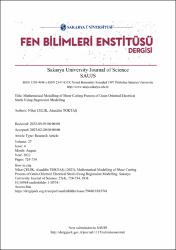| dc.contributor.author | Celık, Nihat | |
| dc.contributor.author | Toktaş, Alaaddin | |
| dc.date.accessioned | 2024-02-05T15:58:19Z | |
| dc.date.available | 2024-02-05T15:58:19Z | |
| dc.date.issued | 2023 | |
| dc.identifier.issn | 1301-4048 | |
| dc.identifier.issn | 2147-835X | |
| dc.identifier.uri | https://doi.org/10.16984/saufenbilder.1183741 | |
| dc.identifier.uri | https://search.trdizin.gov.tr/yayin/detay/1194024 | |
| dc.identifier.uri | https://hdl.handle.net/20.500.12462/13966 | |
| dc.description.abstract | This article proposes a regression model for the shear-cutting process of grain-oriented electrical steel magnetic cores of transformers made from different gages and magnetic properties of steels. In the experimental runs, 3 levels for thickness (230, 270, and 300 µm) and 4 levels for magnetic features of electrical steels are considered. Core steels are supplied as foils and slit to designed lengths in slitting machinery along the rolling direction of coils. The best magnetic features rely on the rolling direction of the coil and the transverse direction of the coil is subject to the shear-cutting process. The result of cutting operations, discontinuities, and degradations in magnetic properties may occur because of deterioration in crystallography and strain gradation on laminated sheets. Shear-cutting process factors have a strong influence on magnetic degradation even the magnitude of the no-load loss of the transformer core. In this study, the mathematical relation between shear cutting factors sheet thickness ST, counts of hits CH, and the response burr length BL is determined using regression modeling. For this purpose, the process parameters of GEORG TBA 400 cut-to-length machinery in use core production is studied. The calculated coefficient of determination is close to almost 1.00 i.e., R2 = 0.9896 which means the factors are sufficient to model the response, and the model is obtained with a good prediction performance. The aim of the present study is building up a useful process control tool for the machinery and raise a discussion alike process in industry. | en_US |
| dc.language.iso | eng | en_US |
| dc.relation.ispartof | Sakarya Üniversitesi Fen Bilimleri Enstitüsü Dergisi | en_US |
| dc.rights | info:eu-repo/semantics/openAccess | en_US |
| dc.rights | Attribution-NonCommercial 4.0 International | * |
| dc.rights.uri | https://creativecommons.org/licenses/by-nc/4.0/ | * |
| dc.subject | Shearing | en_US |
| dc.subject | Regression | en_US |
| dc.subject | Burr | en_US |
| dc.subject | Deformation | en_US |
| dc.subject | Modelling | en_US |
| dc.title | Mathematical Modelling of Shear Cutting Process of Grain Oriented Electrical Steels Using Regression Modelling | en_US |
| dc.type | article | en_US |
| dc.contributor.department | Balıkesir Üniversitesi | en_US |
| dc.identifier.volume | 27 | en_US |
| dc.identifier.issue | 4 | en_US |
| dc.identifier.startpage | 724 | en_US |
| dc.identifier.endpage | 734 | en_US |
| dc.relation.publicationcategory | Makale - Ulusal Hakemli Dergi - Kurum Öğretim Elemanı | en_US |
| dc.buozel | trdizinideal | en_US] |
| dc.department-temp | Balıkesir Üniversitesi, Balıkesir, Türkiye Balıkesir Üniversitesi, Balıkesir, Türkiye | en_US |
| dc.identifier.trdizinid | 1194024 | en_US |
| dc.identifier.doi | 10.16984/saufenbilder.1183741 | |



















